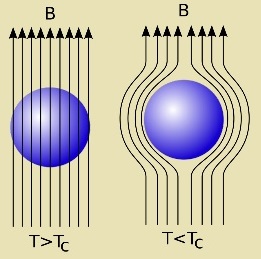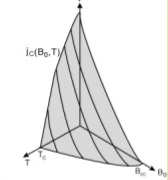superconductor definition
Before understanding the superconductor lets see what is superconductivity, it is the flow of electric current without resistance in certain metals, alloys, and ceramics at temperatures near absolute zero, and in some cases at temperatures hundreds of degrees above absolute zero = -273ºK. Therefore superconductor is the material having almost zero resistivity and behave as diamagnetic below the superconducting transiting temperature.
Superconductor have the ability to conduct electricity without the loss of energy. Unlike when current flows in an ordinary conductor, for example copper wire, some energy is lost.
Superconductivity was first discovered in 1911 by the Dutch physicist, Heike Kammerlingh Onnes. Onnes, felt that a cold wire’s resistance would dissipate. This suggested that there would be a steady decrease in electrical resistance, allowing for better conduction of electricity.
Hence at some very low temperature point, scientists felt that there would be a leveling off as the resistance reached some ill-defined minimum value allowing the current to flow with little or no resistance.
The understanding of superconductivity was advanced in 1957 by three American physicists-John Bardeen, Leon Cooper, and John Schrieffer, through their Theories of Superconductivity, know as the BCS Theory.
Heike Kammerlingh Onnes Experiment
He passed a current through a very pure mercury wire and measured its resistance as he steadily lowered the temperature. Much to his surprise there was no resistance at 4.2K.  At this temperature electrical resistance (opposition of a material to the flow of electrical current through it) diminished, which means best situation for conductivity or a state of electricity-superconductivity.
At this temperature electrical resistance (opposition of a material to the flow of electrical current through it) diminished, which means best situation for conductivity or a state of electricity-superconductivity.
General Properties of Superconductor
Electrical resistance: Virtually zero electrical resistance.
Effect of impurities: When impurities are added to superconducting elements, the superconductivity is not loss but the transition temperature i.e. Tc is lowered.
Effects of pressures and stress: certain materials exhibits superconductivity on increasing the pressure in superconductors, the increase in stress results in increase of the Tc value.
Isotope effect: The critical or transition temperature Tc value of a superconductors is found to vary with its isotopic mass. i.e. “the transition temperature is inversely proportional to the square root of isotopic mass of single superconductors.” i.e Tc α 1/ ²√M
Magnetic field effect: If Strong magnetic field applied to a superconductor below its Tc, the superconductor undergoes a transition from superconducting state to normal state.
Meissner effect of Superconductor
The complete expulsion of all magnetic field by a superconducting material is called “Meissner effect”.
Normal state: T > Tc
Superconducting state : T < Tc
The Meissner effect is a distinct characteristics of a superconductor from a normal perfect conductor. In addition, this effect is exhibited by the superconducting materials only when the applied field is less then the critical field Hc.
Important Factors to define a Superconducting State of Superconductor
The superconducting state is defined by three very important factors that include:
- critical temperature (Tc)
- critical field (Hc)
- critical current density (Jc).
Each of these parameters is very dependent on the other two properties present in a superconductor.

Critical Temperature (Tc)
The temperature at which a material electrical resistivity drops to absolute zero is called the Critical Temperature or Transition Temperature Tc. Below critical temperature, material is said to be in superconducting state and above this it is said to in normal state. Below this temperature the superconductor also exhibits a variety of several astonishing magnetic and electrical properties. Some values of critical temperature for different metals you can see below:
Metal Critical T(K)
Aluminum 1.2K
Tin 3.7K
Mercury 4.2K
Niobium 9.3K
Niobium-Tin 17.9K
Tl-Ba-Cu-oxide 125K
From the below figure it can be seen that the electrical resistivity of normal metal decreases steadily as the temperature is decreased and reaches a low value at 0K called Residual Resistivity.

Electrical Resistivity Vs Temperature Plot for Superconductors and Normal Metals
Critical magnetic field (Hc )
Above this value of an externally applied magnetic field a superconductor becomes non-superconducting .This minimum magnetic fields required to destroy the superconducting state is called the critical magnetic field Hc
Hc = Ho[1-(T/Tc)2]
Critical current density (Jc)
The maximum value of electrical current per unit of cross-sectional area that a superconductor can carry without resistance.
Types of Superconductor Materials
Type I: Soft superconductor
This type of superconductor can tolerate impurities without affecting the superconducting properties. Only one critical field exists for these superconductors and the critical field value is very low. It exhibits perfect and complete Meissner effect. In type I superconductor the current flows through the surface only. These materials have limited technical applications because of very low field strength value. The materials include Pb, Hg ,Zn etc.
Type II: Hard superconductor
This type of superconductor cannot tolerate impurities, hence the impurity affects the superconducting property. These materials have two critical fields Hc1(lower) & Hc2(upper) and critical field value is very high. Hard superconductor don’t exhibit perfect and complete Meissner effect. It is found that current flows throughout these materials. These materials have wider technology of very high field strength value. Example include Nb3Ge, Nb3Si.
Superconductors that require liquid helium coolant are called low temperature superconductors. Liquid helium temperature is 4.2K above absolute zero.
Superconductors having their Tc values above the temperature of liquid nitrogen (77K) are called the high temperature superconductors.
Superconductor Materials
Some metals become superconductors at extremely low temperatures. Some include mercury, lead, tin, aluminum, lead, niobium, cadmium, gallium, zinc, and zirconium. Unfortunately, the critical temperatures are too low for practical application.
Metal alloys like Nb-Ti, and Nb-Zr are usually Type II superconductors. Metal Alloys have higher critical temperatures and magnetic fluxes than pure metals. As a consequence of their properties, they are more useful for practical applications than pure metals.
Iron-based superconductor materials contain layers of iron and a pnictide such as arsenic or phosphorus .This is currently the family with the second highest critical temperature, behind the cuprates.
The crystalline material, known chemically as LaOFeAs, stacks iron and arsenic layers, where the electrons flow, between planes of lanthanum and oxygen.
Application of Superconductor
- Powerful superconducting electromagnets used in maglev trains, Magnetic Resonance Imaging (MRI) and Nuclear magnetic resonance (NMR) machines, magnetic confinement fusion reactors (e.g. tokomaks), and the beam-steering and focusing magnets used in particle accelerators.
- Superconducting generators has the benefit of small size and low energy consumption than the conventional generators.
- Very fast and accurate computers can be constructed using superconductors and the power consumption is also very low.

- Superconductors can be used to transmit electrical power over very long distances without any power or any voltage drop.
- Magnetic levitation, maglev, or magnetic suspension is a method by which an object is suspended with no support other than magnetic fields. Magnetic force is used to counteract the effects of the gravitational and any other accelerations. The two primary issues involved in magnetic levitation are lifting force that provides upward force sufficient to counteract gravity, and stability insuring that the system does not spontaneously slide or flip into a configuration where the lift is neutralized.

Application of superconductor
